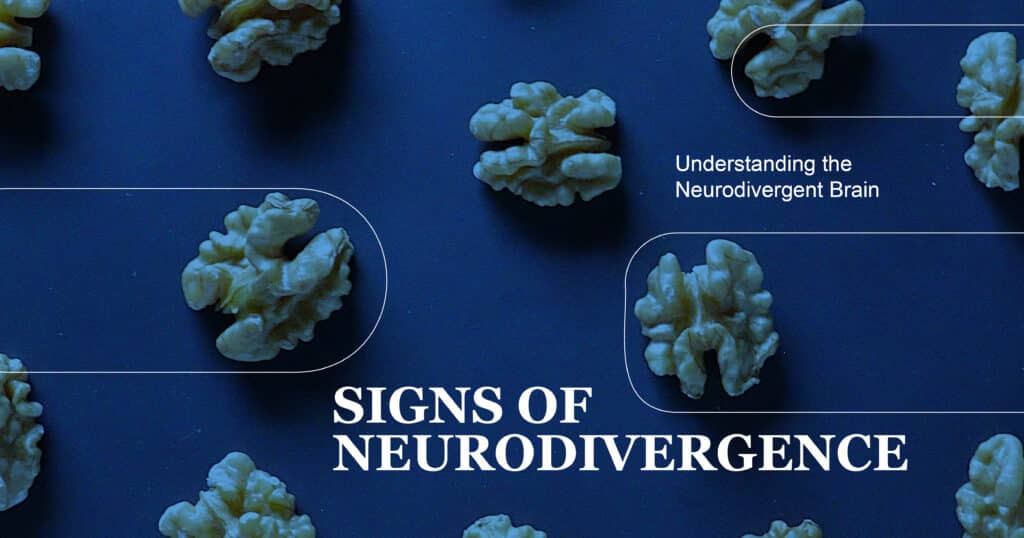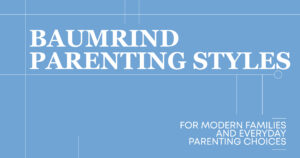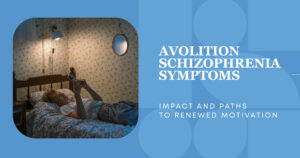Neurodivergence describes the spectrum of the human cognitive process whereby a person’s information intake, social interaction, and reality experience vary from the typical. These differences are not a problem but rather deviations in the human effort to enable a much broader level of reasoning.
A neurodivergent person could be someone with Autism Spectrum Disorder (ASD), Attention Deficit Disorder (ADD), Attention Deficit Hyperactivity Disorder (ADHD), dyslexia, dyspraxia, and other cognitive deviations.
Understanding the signs of neurodivergence can change a person’s life. Many people navigate through life feeling different without understanding why. While some may struggle in a traditional school or workplace, others might excel in specific areas yet face hurdles in daily activities.
Knowing what it means to be neurodivergent can help people accept their distinctive strengths while receiving the necessary support for their challenges. This guide discusses neurodivergence, its meaning, traits, prevalence, challenges, and available support.
What Is Neurodivergence?
Neurodivergence describes an individual’s unique cognitive functioning and differs from the neurotypical model. It may impact thinking, sensing, interacting, and managing feelings. Unlike the traditional approach, which sees these differences as disorders to be fixed, the neurodiversity movement strives to appreciate these variations as facets of human diversity.
Understanding the Concept of Neurodiversity
Sociologist Judy Singer proposed the concept of neurodiversity in the 1990s. It advocates the position that conditions such as autism, ADHD, and dyslexia represent normal differences in the human population.
It is more constructive to emphasize the contribution neurodiverse individuals make rather than the shortcomings they face resulting from societal structures. In this case, that approach is referred to as the neurodiversity movement.
The Difference Between Neurodivergence and Neurotypical Thinking
Neurotypical people process information, emotions, and social interactions in ways that coincide with societal norms. Their mental capabilities tend to slot neatly within prevailing frameworks on how people learn, interact, and behave.
A neurodivergent brain may process sensory information more intensely than most, have difficulties with executive functioning, and present differing approaches to learning and problem-solving. Although some neurodivergent people struggle in standardized settings, they perform remarkably well in imaginative, innovative, and attention-demanding tasks.
How Common Is Neurodivergence?
Even though neurodivergence encompasses a wide spectrum of people across various ages, it still remains an elusive topic. Generally, people traverse through life without so much as a second thought about neurodivergent conditions. This largely happens because they lived during periods when the term neurodiversity wasn’t well popularized.
Prevalence in Children and Adults
The recognition of neurodivergence typically occurs in childhood, yet some adults may realize their neurodivergent characteristics later in life. Studies indicate that around 1 in every 36 children is diagnosed with autism, and approximately 9% have been diagnosed with ADHD. Other learning disabilities, such as dyslexia, are also prevalent, impacting an estimated 1 in 5 school-aged children.
Many neurodivergent adults were either misdiagnosed or went undiagnosed. They could have been viewed as “lazy,” “cold,” or “odd” instead of receiving the help they required. Growing awareness enables more adults to identify neurodivergent characteristics and pursue structured diagnostic processes.
The Spectrum of Neurodivergent Conditions
Neurodivergence covers a broad range of conditions, each having distinguishing characteristics. Sometimes, a person may fit perfectly into one category, while other times, an individual may “combine” characteristics from several neurodivergent categories. Types of neurodivergence include:
- Autism Spectrum Disorder (ASD), which affects social communication, sensory processing, and behavior.
- Attention Deficit Hyperactivity Disorder (ADHD), which impacts focus, impulsivity, and executive function.
- Dyslexia, which affects reading, writing, and language processing.
- Dyspraxia, which influences motor coordination and spatial awareness.
- Tourette Syndrome, which causes involuntary movements and vocalizations.
- Sensory Processing Disorder (SPD), which results in heightened or reduced sensitivity to sensory stimuli.
Since neurodivergence exists on a spectrum, no two individuals will have identical experiences, even if they share the same diagnosis.
The Complexities of Neurodivergence
Myths and Misconceptions About Neurodivergent Individuals
Myths related to neurodivergence often create stigma alongside misunderstanding. One of these includes the ill-placed belief that neurodivergent individuals have lower intelligence than others. However, there is no direct correlation between neurodivergence and one’s intelligence. Many neurodivergent people are high performers in specific fields, and they showcase outstanding creativity, analysis, or problem-solving skills.
Visibility of Neurodivergence
Another myth is that neurodivergence is always externally observable. In truth, most neurodivergent people conceal their symptoms to conform to semi-professional neurotypical standards. Such cultural masking may cause burnout, anxiety, or problems with self-image.
Neurodivergence Beyond Childhood
Another misunderstanding is that neurodivergence only affects children. Many adults find out that they are neurodivergent later in life because they notice behaviors within themselves that they observe in their children or their colleagues. Having a late diagnosis can often prove to be very beneficial as it allows a person to rethink previous challenges in light of new understanding and provides help.
Strengths and Challenges of a Neurodivergent Brain
Neurodivergent individuals showcase their remarkable skills in pattern recognition, problem-solving, and creative thinking, which reflect their strengths and weaknesses. Due to exceptional pattern recognition, many neurodivergent individuals excel in various fields like art, math, music, and technology.
On the other hand, daily living can be difficult through balance challenges like sensory sensitivities, executive functioning, and social communication. Adapting to different work, educational, or social settings is essential for many neurodivergent individuals to thrive.
Signs of Neurodivergence
Common Traits and Behaviors
The signs of neurodivergence are subtle and unique to each individual and their condition. Some signs include difficulties in social communication, a heightened or decreased response to sensory stimuli, repetitive behavior, and distinct strategies for processing and retaining information.
For instance, a neurodivergent individual may be overly sensitive to certain sounds and textures, struggle with planning or time management, and excel in specific areas of interest while facing challenges with routine activities.
Recognizing Neurodivergence in Different Age Groups
Neurodivergent Behaviors in Children include delay in speech development, difficulty following multistep instructions, and problems interacting with peers. Issues related to managing emotions and social anxiety may develop in the teenage years. In neurodivergent adults, it can appear as organizational burnout, hostility towards work, and feeling disconnected from the conventional office environment.
What to Do If You Think You Are Neurodivergent
Self-Assessment and Recognizing Symptoms
Do not forget that self-evaluation might be helpful if you are questioning, “Am I Neurodivergent?” Consider whether you have encountered ongoing difficulties with executive functioning, social engagement, or sensory integration. While unofficial online self-tests may be insightful, conclusive diagnoses come from assessments conducted by experienced clinicians.
When to Seek a Professional Evaluation
To better understand your daily struggles, consider getting a professional evaluation. A diagnosis can constructively validate your concerns, provide enabling support, and deepen your understanding of cognitive strengths and challenges.
Treatment and Support for Neurodivergent Individuals
Therapy and Behavioral Strategies
Reasonably, some neurodivergent persons do need therapies that tend to their particular difficulties. CBT deals with emotional regulation issues, while OT nurtures sensory integration and motor proficiency. Communication and organization or planning difficulties may also be addressed by speech therapy or executive function coaching.
Lifestyle Adjustments and Coping Mechanisms
To cope with everyday life, one can implement organized schedules, modify workstations to suit sensory preferences and engage with the neurodivergent community. In most cases, individuals led to accept their neurodivergence perform better than those who try to suppress it.
How Hillside Horizon for Teens Can Help
At Hillside Horizon for Teens, we offer neurodivergent support and therapy. Individualized, tailored therapy and coaching are provided to suit the distinct requirements of every individual. If you or a loved one is suspected to be neurodivergent, you are welcome to contact us, and we will guide you through the process.
Acceptance of neurodiversity starts with understanding it. If you question your neurodiversity, there is support and guidance out there that will help you explore and navigate your life better. Contact Hillside Horizon for Teens today, and let us help you.
FAQ
How do I know if I am neurodivergent?
For those of you who have wondered, “Am I neurodivergent?” This may pertain to how you think, process information, or socialize. It might also involve focus-related challenges, sensitivities to stimuli, distinctive methods of acquiring knowledge, or passionate preoccupations with certain subjects. While self-assessments can provide clues, receiving a professional diagnosis would be the optimal approach to confirming neurodivergence.
What are the 11 types of neurodivergence?
Neurodivergence entails conditions such as Autism Spectrum Disorder (ASD), attention deficit hyperactive disorder (ADHD), and dyslexia. It also includes dyspraxia, dyscalculia, dysgraphia, Tourette’s syndrome, sensory processing disorder (SPD), obsessive-compulsive disorder (OCD), schizophrenia, and hyperlexia. The degree to which a person suffers from these conditions differs and often involves multiple traits from different categories.
What are the symptoms of neurodiversity?
Neurodivergence is often characterized by challenges with social interaction, executive function, sensory processing, hyperfocus, easily distracted, or repetitive behaviors. Additionally, some people have marked analytical, creative, or problem-solving abilities.
What is a high-functioning neurodivergent?
People considered “high functioning” appear to manage everyday tasks while displaying some neurodivergent traits. This is misleading since most still struggle with emotion regulation, sensory coping, or executive functioning issues. Labels are not helpful, but what is more beneficial is focusing on the person’s competencies, what support they need, and identifying goals.
Can neurodivergence be diagnosed later in life?
Yes, many adults receive an ADHD diagnosis after recognizing self-neurodivergent traits. This is especially the case for women and people of color, who tend to be overlooked during their childhood and adolescent years. While this form of diagnosis is helpful from an understanding perspective, that type of identification assists in addressing support and enhancing comprehension of the individual’s underlying difficulties.





